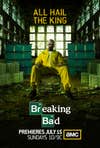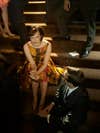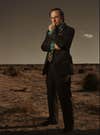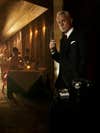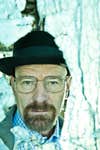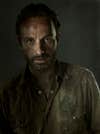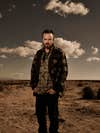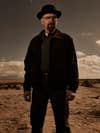Interview: Photographer Frank W. Ockenfels III On Shooting Breaking Bad
A high-profile TV, movie, and music shooter walks us through his fascinating process
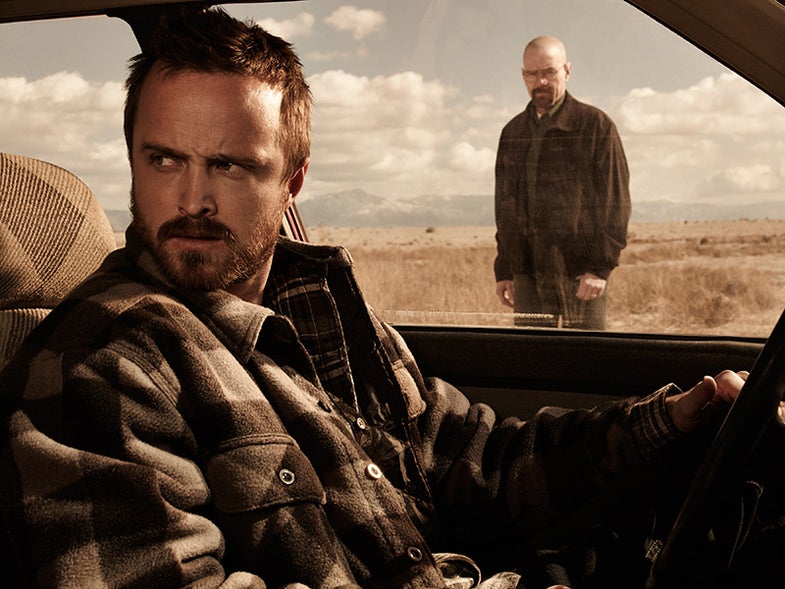
Like many of you, I’m a huge fan of Breaking Bad. So, when I saw the moody desert character portraits AMC released to promote the final season, I was excited and a little curious. They were shot by Frank Ockenfels III, a commercial photographer who has shot everything from big time movie posters (Harry Potter, Men In Black 3) to a wide variety of TV advertisements. He has one of the most fascinating jobs around and he let us pick his brain about what it’s like to shoot billboard-sized photos of very famous people. Check out Frank’s portfolio here, and be sure to follow him on Instagram.
**How did you get started shooting for TV and movie posters? **
It’s funny because I kind of fell into it. I started in music where I didn’t have massive productions. I’d show up with myself and one assistant. Maybe two. The idea was how much could you possibly get done in a day. You have a lot of photographs to cover.
One day, a woman named Kimberly Rock from Grey Entertainment saw my work and thought I might be perfect to change the way they do television advertisements. She hired me, and what I came to understand later, was that if it didn’t work, she’d lose her job. We went out and did Murder in the Heartland. We shot Tim Roth and Fairuza Balk and Brian Dennehy and Randy Quaid down in Texas. They used to shoot everything against gray seamless, and I said, “Well, let’s go out and see what kind of natural light we can find.” I tried to make it more real, a lot closer to what the filmmakers were making.
Seems like they were pretty happy with your work. Did it snowball from there?
The second round came when a company in LA called BLT started pushing me quite a bit toward doing movie posters and Harry Potter world. I did three rounds of that over the years.
**That whole industry seems so foreign to many people. The photography is obviously important, but relationships seem to play a huge role in what you do. **
The act of doing celebrity photography half the time has nothing to do with if you’re the right person for the job. A lot of times these companies and agencies are handed the person the celebrity is closest to or who they feel comfortable around. I have been on both ends of that spectrum. I’ve been handed to a group of people for whom I was not their first choice, but the Celebrity would say, “I want Frank to do it because I’m comfortable with him doing it. I know that he’ll be on my side.”
How did you get hooked up with AMC?
A guy named Brad Hochberg, who owns a company named Refinery, which is a design agency and ad company for the television industry, suggested me to do the Mad Men stuff. I’ve done the key art and the gallery work for Mad Men every year. Because of that relationship I ended up doing every show they had. They brought me into The Killing, then Hell on Wheels, and last year, I was introduced to their other biggest titles, Breaking Bad, and the Walking Dead.
Andrew Lincoln of The Walking Dead (AMC)
**How do you make the creative leaps required to shoot such varied subject matter? Just making the leap from Mad Men to The Walking Dead seems daunting. **
It’s what I love to do. I’ve based my career around the concept of never having just one idea. The two comments about my website are “It’s amazing how diverse your website is,” or “What is it you actually do?” It’s great.The people who love the diversity are the ones who understand how I work. A lot of these shows, like The Walking Dead, they don’t want the same thing. They want to see how far things can go. The actors don’t want to do the same thing every year, either. If they show up every year and you put them in front of a grey seamless, they’re going to look at you and say, “Why can’t we just use the pictures from last year?”
{C}{C}{C}{C}{C}{C}{C}
**Is it a tough process to get your ideas approved? With so many people involved in the production, it seems like there could be a lot of back and forth. **
It can be. The ad agency — in this case it was Refinery — did the show this year. They present ideas to Vince and he may have some ideas too. They flesh those out. There are concepts that have been mocked up or thought out. We have to come up with an idea to create pictures for the gallery and the press book as well.
How did_ Breaking Bad_ shoot in the desert develop?
Every year they had talked about going out in the desert. It’s very ambitious because you never know what’s going to happen. It’s weather. If it starts to rain, you have a whole cast of people standing there and all the money has been spent and you can’t shoot.
With this year’s Breaking Bad shoot, every day we were there was different weather. If you’ve ever been to Albuquerque you know that you can watch storms come toward you for like an hour. And then all of a sudden you’re just being poured on. Or, you can watch a whole electrical storm go around you as you’re looking into a blue sky. I knew this when they asked me to do it. I said, “Are you sure?” And they said it would be good. Everything would be fine. Vince said he really wanted to make a point in the key art that everybody was in a different point in the day.
You definitely notice the differences when you look through the photos.
Oddly the photo gods listened to Vince and gave him the day he wanted. On the day of the shoot, we got there and it was snowing. We were standing there waiting for the sun to come up. We’re standing in the desert, the sky is black, and we’re being snowed on. After we shot the second person, we had to break for a while because we saw the weather coming. The actors totally understood. By the end of the day, we had bright blue skies without a cloud to be found. We had a beautiful sunset. It was a very bizarre day.
Is there a lot of pressure to have all these high-profile actors on set waiting for you to shoot?
They have all been really great. They’re very giving actors. Working with guys like Jon Hamm, Andrew Lincoln and Bryan Cranston is a gift. They walk in and the look at you and they talk to you by name and they remember the work you do. They really want to participate and see how far they can push the photography. They don’t complain about being there for the day or how much they have to do. It’s amazing.
But, when it goes wrong, it really goes wrong. You have a whole set of people standing there looking at you, saying “what do we do?” That’s when you have to pull out your bag of tricks. That’s the funny thing about it. When I started out, it was me, a camera bag, and a couple lights. Now, you don’t know what you’re walking into sometimes.{C}{C}{C}{C}{C}{C}{C}
**How big do these sets get? I’m imagining truckloads full of gear in some cases, like a movie production. **
When we’re shooting Mad Men, we might have 54 packs and 67 heads. It’s literally a five ton truck full of equipment for a photoshoot with eight assistants running around. It can be very unnerving. I’m not the kind of person who likes to lean back and say “you go do this and you go do that.” I like to have my hands on things as I’m placing lights and doing things.
You have to set so many things up. You might have an actor for an hour and you have to do four or five shots. If you’re in the studio, you’ll have them all pre-lit, but if you’re outside, it’s tougher. You can make marks on the ground, but you have to have some luck.
So you’re your own photo assistant in a way.
Every time you turn a light on you’re seeing things differently no matter how many times you’ve done a lighting setup. It’s going to constantly change from where you’re standing. So, I like to be there as things are being set up. I like when things go slightly wrong and you have to correct them or adapt them to a situation.
Have you ever had a big production go really wrong?
No, because you have to have the answer. It might not go exactly how you want it to go, but if everyone sees that you’re trying to do something different, it’s part of the process. Networks like AMC and FX want to see what happens when you push the envelope. It’s the same way their television shows aren’t safe. It’s kind of funny because it trickles down. They create their key art and their billboards the same way they create their shows. If the advertising for the show was safe, it wouldn’t make any sense with the programming.
Have all the challenges of this kind of shooting changed your overall style at all?
It ups your game. You know what they say about tennis: if you play with somebody better than you, your game will get better. At one time, it was all about putting people in front of a gray seamless and saying “put that big Octobank over there and we’ll light the crap out of it and we’ll figure it out afterward.”
Instead, I get these massive lighting ideas that they want to try and it can come from anywhere from a picture someone took on an iPhone to a painting. We’ve done painting references and I love those almost more than the photography. With a painting, there’s a sense, a feeling that they’re looking for. It’s great to be able to try and execute that or solve the problem.{C}{C}{C}{C}{C}{C}{C}
How different is it to shoot pictures of an actor in character than a normal portrait?
It depends. I’ve been lucky enough to work with a lot of actors who appreciate that I’m not there doing their portrait. I’m there to photograph the character to illustrate the show. Andy Lincoln from The Walking Dead would go run around in 90-degrees and come back breathing heavily and covered in sweat and say, “Ready to go?” And we’d go shoot. He works himself into the process. Jon does the same thing when we’re doing Mad Men. Bryan does the same thing when we’re doing Breaking Bad.
Bryan will stand there, and he and Jesse will be joking around. Then we’ll say “go” and they both drop into these faces. It’s like someone flips a switch. And they get it. That’s what I need. They’re amazing actors.
Are there some actors who don’t get it?
Sometimes when you’re shooting a young actor, they won’t understand why we’re shooting the pictures or what they’re for. I have to explain that it’s the advertising for your show or the gallery pictures. They want to see your character. So, if they’re sitting there and they want to wear a certain outfit they wouldn’t typically wear on the show, it’s a challenge.
**Have you shot some of the actors in and out of character? **
Yeah. I have shot Bryan and Jesse for The Hollywood Reporter not in character. They came through and I shot their portraits. It was supposed to be more of a somber shoot. But, it is a very different thing to see someone outside the context of the show and say to them, “Let’s take pictures how you want to take pictures.” If you shoot Jon Hamm outside of the context of Don Draper, his hair might be messed up. He might not be so put together. I’ve seen him outside in public. He’s not always Don Draper. He has a great sense of humor.
Obviously you try to keep up with all the shows you’re shooting for, but do they give you info about the upcoming season so you can make the art match?
Yeah, you’re supposed to know what’s going on. You should know why things are going to be a certain way. I have shot shows that I’ve known nothing about because they don’t give you a script. They give you a synopsis of where they’re going with it.
Some shows require you to read scripts and some will send you a pilot and they want you to watch it before you shoot. Some don’t send you anything and it’s your job to figure it out. They’ll tell you a timeframe and they’ll say “this is what’s going on” and you’ll go from there.
You never know what you’re going to be handed and you have to be able to accept it. They have enough egos running around sometimes between showrunners, actors, producers, and directors, that they don’t need one more person to argue. You’re the photographer. They hire you to do your craft. You walk in the door and say “What can I do to make this perfect?” And know that you’re the one who’s going to take this ship and turn it in a direction that everyone wants to go without any ego or craziness.
The hardest thing is to shoot a show where no one has done anything. I’ve worked on movies and TV shows where the photo shoots happen before the show has even started. I’ll go to an actor and say, “What would this character do in this situation?” And they’ll say, “I have no idea. I haven’t had a day on set yet. I’m only assuming this is where I’d go.” And we try it and see how we feel about it.{C}{C}{C}{C}{C}{C}{C}
Do they keep someone from the show on set to keep things correct in the universe?
The show people don’t always show up. If you’re working for the network, they might send you a line producer because they know the actors. They’ll walk around and tell them when it’s their time on set. They’re used to that person coming over and asking them questions.
So the creators aren’t there looking over your shoulder?
Creators don’t always come to the shoot. They might pop over for a couple minutes to say hi. They’ve already put their two cents in prior and they appreciate what has to happen and they don’t want to stand there and get in the way. If someone stands there and every four minutes they say, “I’m not really sure about that,” it could slow everything down. You already have other people who are going to say that.
That makes you the photographer and director on set then, in a way.
I started directing years ago with music videos and commercials — and I still do it — but I learned a lot about how to direct people. I learned you should never act out what you want, just tell the actor what you’re thinking and let them figure it out. If you say, “I want you to walk over here and lean against the wall like this,” you’re influencing their action. You need to let them interpret those four or five words might mean. It’s the better approach.
It’s like looking at your kid and saying, “This is how you do this.” The kid will do exactly what you just did. He’ll totally parrot the moment. You don’t want that with an actor. That actor was hired to be who he is. Good actors will look at you and say, “Don’t do that.” (Laughs). They just want you to tell them where to be and they’ll show you how they’re going to get there. You can’t be offended by that. You have to appreciate it.
Can you talk a little bit about what kind of setup was in place for the Breaking Bad shoot in the desert?
We had six assistants and a large truck full of equipment drive from Los Angeles to Albuquerque. Two of the assistants did the nine hour drive. We had two pre-light days because of weather and sure enough we needed both of them. The first day we had sun that rolled into pouring rain in the afternoon. The second day, we couldn’t go out in the morning because it was still raining. When it stopped raining, the wind came up and we were literally being blown over.
Knowing we were out in the desert, we had a Sprinter van that had some of the gear in it. We emptied it out and put the digital station inside while we were shooting so the client would be able to see the monitor and it would be safe from the weather and the wind and everything. We were on a roadside, and every time we’d move, the Sprinter truck would drive to where we were shooting, and we’d plug the cable into the camera and I’d be outside and the images would go into the van and people would say yes or no.{C}{C}{C}{C}{C}{C}{C}
So, you’re shooting most of this stuff on medium format digital backs, right?
Nine times out of ten, because of the size of billboards and everything, we shoot a lot on the Hasselblad and the Phase One backs. We had to step back a little on the Phase One backs because the higher resolution ones are so high-resolution that they almost have to retouch the sharpness out of them. I couldn’t tell you which one we’re using, but we’re not using the highest-end ones because people complained that they were too clear.
Film was never this sharp. It’s sharper than real life. You shouldn’t be able to read a hair inside the tear duct of someone’s eye. On one of those high-end backs, though, you can almost read what someone is thinking. It’s kind of terrifying.
So even when you’re shooting billboards, the whole megapixel race doesn’t apply?
I think they need to work less on making backs higher resolution, and more on making them able to shoot in darker areas. Being able to shoot with a medium format camera at ISO 2000 would be really nice. You have to know you can’t have too many dark areas. I grew up shooting film most of my life and I made the change. It’s the never-ending process of “Here’s a new tool, figure it out.” It’s a great thing. It has allowed us to do a lot of things we wouldn’t have been able to do in the past.
How were you adjusting as the light moved throughout the day?
When we were shooting, the truck had to come over and sit right behind me. He’s in front of us, and to fill him, we put a white silk on the side of the truck that was behind me. We shot a strobe head into it and it bounced back to fill him subtly. We used natural light as much as we could and then we added the flare.
You use whatever you can use. If we had put a silk up, it would have blown over because of the wind. The truck’s not going to blow over. Was it ideal light? No. But, it worked out really well, I think.
Did you keep the backgrounds as they were? Or were they changed a lot?
Each moment in the key art, the clouds behind the actor or actress, are the clouds that were actually in the sky. Usually you have to shoot plates of that stuff and put it back in. It was great. At every moment, it could have all gone wrong. But it went right and allowed us to have these amazing moments out in the desert.{C}{C}{C}{C}{C}{C}{C}
Looking through the images, the one of Saul (Bob Odenkirk) really stands out from a lighting standpoint. He looks almost completely different than the others. When was he shot?
He was the last person shot. He was shot as the sun was going down. The first person shot that day was RJ. He was shot at 6:30 in the morning. Bob was shot at 7:00 at night. Direction of light is really important. If we’re shooting a bunch of people at different times of day, we have to make sure that the light at least makes sense. If there’s an edge on one side and a key on the other, it always has to match up on everyone’s faces. With this shoot, though, they didn’t care. They didn’t want everyone to be that close. Everyone lined up because they were all in the desert, but they wanted everyone to feel a little different. It doesn’t feel like everyone is in the same moment.
Last season’s Breaking Bad art was in a much different setting, can you talk a little about how that stuff came about?
We started with the shot that has the two of them sitting in haz-mat suits in the living room with a beer. That’s all on-set and controlled. They wanted as much content as they could get, so I said, “We’re going over to this warehouse at a train depot in downtown Albuquerque to do photos of Bryan sitting in the chair surrounded by the bins of meth. There’s all this amazing light in this old place with broken windows. Why don’t we just have the two of them come over and I’ll run around with a 35mm format camera and I’ll shoot a bunch of pictures.”
We were shooting right to card, not tethered to a computer. And even though they had been shooting with me, they were a little hesitant because they couldn’t see the photos on the big screen. I could show them on the back of the camera.
Is that how the broken window photos came about? I particularly liked those portraits.
I came around this one area and there was a broken window. I shot through the broken window, and when I processed the images, the light was kind of blue because the glass was reflecting the sky. So, when I went to pull the color, the glass almost became the color of the meth that they cook. It was totally a happy accident. It was not a planned photograph. We totally just found that spot as we were walking around taking pictures about 40-minutes before we started shooting the key art for the last season.{C}{C}{C}{C}{C}{C}{C}
So there was no lighting setup for those photos?
It was all natural light. There’s nothing to it. I teach classes and I teach people not to overthink things. People get nuts and think they need all these lights. I’ll have people show up to my classes and they’ll tell me all these things they want to do, and I’ll tell them to go over to Home Depot and buy a light. They say, “That’s only 12 bucks!” Or, I’ll say use your cellphone. There are a million things you can do that doesn’t require a truckload of equipment.
**Full disclosure: I spent at least a few minutes trying to figure out how you could get lights into that spot and get it to look like that. I totally overthought it. **
When I’m teaching people how to manipulate light, I hand everyone a silver card and I tell them this card can help you create every kind of image you’re ever going to want to do. Then, when you bring in the big lights, you can still use the silver card to move light around. You can walk into a room and say, “that lightbulb is all I need to take a picture.”
I just did a lecture in San Francisco last week and I told everyone how important it is to take chances and make mistakes. Don’t’ be afraid. Photography has zero rules. Rules have been applied by people who want to tell you what you shouldn’t do with a camera. But if it creates the vision you want, you should certainly do it.
Is that why you’re such a big fan of Instagram?
I love it. My assistants call me the sheriff. (Laughs). I openly berate people when they post too many food or kitty pictures unless they’re interesting. Especially with photographer friends. I’ve had huge back and forth with photographers who post without a thought behind it. And I say to them, “Come on, you’re a photographer! No one’s telling you what to do.
Find a moment you want to create. You’re an interesting person. You go to interesting places.” You can also find people on there who aren’t professional photographers, but they do the most amazing work. If they can do it, how a professional doesn’t do it is beyond me. They’re seeing this way every day. It’s amazing.
